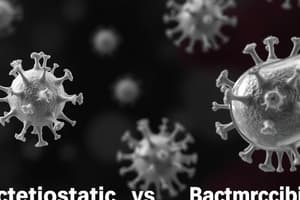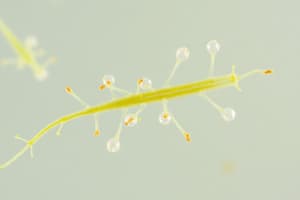Podcast
Questions and Answers
What is the primary mechanism of spore formation in fungal cells?
What is the primary mechanism of spore formation in fungal cells?
- Budding (correct)
- Multiple fission
- Binary fission
- Fragmentation
What is the primary reason for the slowdown in microbial growth during the stationary phase?
What is the primary reason for the slowdown in microbial growth during the stationary phase?
- Depletion of nutrients (correct)
- Accumulation of toxic products
- Increase in pH
- All of the above
What is the phase of the growth curve where the number of microbes increases exponentially?
What is the phase of the growth curve where the number of microbes increases exponentially?
- Stationary phase
- Lag phase
- Exponential phase (correct)
- Death phase
What is the process of an organism breaking into two or more pieces, which then grow into complete organisms?
What is the process of an organism breaking into two or more pieces, which then grow into complete organisms?
What occurs during the lag phase of the bacterial growth cycle?
What occurs during the lag phase of the bacterial growth cycle?
What is the definition of growth in the context of microbial populations?
What is the definition of growth in the context of microbial populations?
What is the primary way that bacteria reproduce?
What is the primary way that bacteria reproduce?
What is the result of binary fission in a bacterial cell?
What is the result of binary fission in a bacterial cell?
What is the process of generating offspring called?
What is the process of generating offspring called?
How often can a bacterial cell divide by fission under favorable conditions?
How often can a bacterial cell divide by fission under favorable conditions?
Which microorganisms also reproduce through binary fission?
Which microorganisms also reproduce through binary fission?
What is the mode of reproduction in which a microorganism breaks up into a number of pieces or spores?
What is the mode of reproduction in which a microorganism breaks up into a number of pieces or spores?
Flashcards are hidden until you start studying
Study Notes
Reproduction of Microorganisms
- Microorganisms reproduce through various methods, including Binary Fission, Spore Formation, Budding, and Fragmentation.
- Binary Fission: a cell divides into two daughter cells after DNA replication, resulting in two identical daughter cells.
- Spore Formation: a mode of reproduction resembling multiple fission, where a microorganism breaks up into a number of pieces or spores, which develop into new organisms like the parent form.
- Budding: an offspring grows out of the body of the parent, where the nucleus divides and one of the daughter nuclei passes into the daughter cell.
- Fragmentation: the mature organism breaks up into two or more pieces or fragments, which grow into complete organisms.
Growth Curve of Microorganisms
- Growth Curve: a graphical representation of the increase in the number of microbial cells in a population over time.
- Four phases of growth are recognized in the growth curve:
- Lag Phase: microbes adapt to the new environment, not yet able to divide, and undergo synthesis of RNA, enzymes, and other molecules.
- Exponential (Log) Phase: cells divide actively, resulting in an increase in the number of microbes, and it is the most optimum phase for microbial growth.
- Stationary Phase: growth rate slows due to nutrient depletion and accumulation of toxic products, causing microbes to stop growing.
- Death Phase: microbes die due to lack of nutrients and accumulation of toxic products.
Key Concepts
- Microbial growth: an increase in the number of microbial cells in a population.
- Microorganisms can reproduce quickly and in various ways, allowing them to survive for billions of years.
- Reproduction is a critical process for microorganisms to increase their population and survive in different environments.
Studying That Suits You
Use AI to generate personalized quizzes and flashcards to suit your learning preferences.




